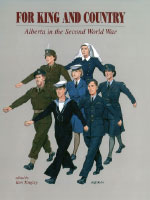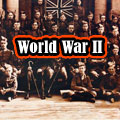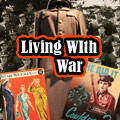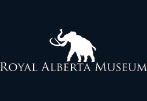Prairie Sailor
Rodney Pike
Reprinted with permission of the author and publisher of For King and Country: Alberta in the Second World War
Ed. Note: Convoy duty played a significant role during the Battle of the Atlantic. Convoys were groups of merchant ships sailing together under the protection of naval warships. The British Admiralty immediately adopted this form of protection in the fall of 1939, and it remained in effect throughout the Second World War. The Royal Canadian Navy remained an important part of the convoy system across the Atlantic for the duration. It was very dangerous duty, as the convoys were forced to travel at the speed of their slowest vessel. Early in the war, the convoys relied upon ASDIC sound-detection equipment to detect and deter U-boats on the shipping lanes. German submarine commanders soon learned ways to overcome the primitive ASDIC system, and the shipping lanes became a killing ground by June 1940. After the spring of 1943 the convoy was converted into an offensive vehicle, with its heavily armed and well informed surface escort vessels capable of destroying enemy submarines lured to their slow moving ships as they crossed the ocean.
The corvettes were small escort-patrol vessels built in Britain and Canada after 1940, and based upon a modified whaling vessel design. Over 300 little Flower Class Corvettes were built, displacing under 1000 tons, and able to make 16 knots. These were replaced in 1942 with the larger River Class, which were classed as frigates. The still larger Castle Class was developed in 1944. During the war frigates and corvettes were the main escort vessels, and served a vital function in keeping the sea lanes open despite the loss of thousands of merchant seamen and their ships.
I am not sure what prompted me, a prairie landlubber, to join the Royal Canadian Navy, or develop the desire to become the Captain of a ship. Perhaps the fact that my Newfoundlander grandfather was Captain of a square-rigged sailing vessel may have had something to do with it. However, I can relate to James Thurber's story about the hen-pecked little man Walter Mitty, who when scolded by his wife would escape by fantasizing that he was a hero bringing in a disabled bomber. Now when my wife criticizes my driving I regain my self assurance by thinking back to the time when I really was a Captain of a ship riding out a hurricane in the North Atlantic.
Joseph Conrad wrote that "[maritime] skill, like skill of all kinds, is not cultivated by the way or at chance times." In peacetime, it takes years of sea-going experience and training before one can qualify for a master's ticket of an ocean¨going ship; but in wartime the process has to be shortened out of necessity.
In August 1939 I was called up and appointed to the Examination Service, gaining some experience in ship handling and dead-reckoning navigation by watching the skippers of the fishermen's reserve in whose vessels we carried out our duties.
Early in 1940 I was sent on loan to the Royal Navy, and after a quick brush up on the customs of the service, officer-like qualities and celestial navigation, I was appointed in "Command" of HMS Moira, based at Freetown, Sierra Leone, in the South Atlantic Station.
HMS Moira turned out to be a converted Scottish fishing vessel, equipped with an ASDIC set and armed with depth charges. It didn't take me long to figure out, taking into consideration the depth where I patrolled and the speed of my vessel, that if I ever dropped any depth charges I would blow myself out of the water.
The crew was composed of six black Kroomen with big powerful shoulders from diving, who came from the Coast of West Africa. One dark night when the big diesel engine broke down, I was holding the flashlight for one who ran the engine. As the light shone on his face, his tattoo marks stood out and I could have sworn that his teeth were sharpened.
I became quite attached to my crew, and they took good care of me and taught me a basic principle about ship handling that was to stand me in good stead later on. They had a wonderful way of expressing things, and I have never forgotten "Softly, softly, catch monkey."
After a few months, I got a chance to take over a coal-burning converted Hull! Grimsby trawler, the HMS Bengali, because the Naval Reserve Captain, a peacetime Pacific Orient Line officer, thought he had been appointed to Freetown to take over the Auxiliary Patrol. The English gentleman, accompanied by his yachtsman, didn't feel he had enough experience but said he would be my First Lieutenant if I became the Captain.
Our first patrol was a thousand miles off. It was just as well, as I had some difficulty with my celestial navigation, and filled my cabin with paper calculations. My English friend was reassuring, and said, "Don't worry, when the time comes to return to harbour you will figure it out."
Fortunately I did, because our job was to meet ships sailing independently from South America and escort them into Freetown, as well as to pick up survivors from ships that had been torpedoed.
The crew was made up of Newfoundland and English fishermen. The trawlers were coal burners, and the boiler room got very hot so we used local stokers, but we also used experienced sailors because when the alarm bells sounded the locals poured out of the engine room.
When the new Flower Class Corvettes began to appear with convoys from the United Kingdom, and I learned that Canada also was building them, I put in a request to be appointed in command of one. The Captain told me I could go if I could find my own way home and the Petty Officer writer in the Admiral's office tipped me off that the HMCS Seaplane Carrier was short a watchkeeping officer, and was either going to the Pacific or a Lend-Lease refill in the USA. The Captain said that if I could command a trawler I should know enough to be a watchkeeper in a carrier.
It was quite an experience, and I learned another fundamental principle about the Navy - if you want to get something done, particularly in an emergency, just find the right Petty Officer to call.
We went to Mobile, Alabama for a refit, and I eventually got back to the Royal Canadian Navy; however, I did not get my immediate command, but was told I could apply for the Command Course, if in the interim I would serve as First Lieutenant on a new corvette, HMCS Woodstock. After a trip on the triangular run connecting Halifax, St. John's and New York, we were sent to Mid-Ocean Escort Force. After this we were back on loan to the Royal Navy, with fourteen other Canadian corvettes, to escort convoys from the UK to Gibraltar, and in the Mediterranean for Operation Torch and the landings in North Africa.
I had the benefit of learning a great deal about how to take care of a ship from our first Captain, a truly professional RN officer, Captain Denny. When we were sent to the Mediterranean, he was replaced by Captain Griffin, who had retired from the Royal Navy, and also was appointed Senior Officer of the Canadian corvettes sent to Operation Torch. I learned a lot from him about naval operations. When we went back to the North Atlantic during the U-boat crisis in the spring of 1943, we got a wonderful ship handler in Lieutenant Jack Watson who learned his trade in the confined locks of the Great Lakes. He let me handle the ship.
Finally in May 1943 I was appointed to the Command Course. Three of us finishing the course were promised the very latest in anti-submarine vessels, the Castle Class Corvettes built in the United Kingdom, on the condition that we would act as work-up officers, "working up" new construction at Pictou, Nova Scotia.








